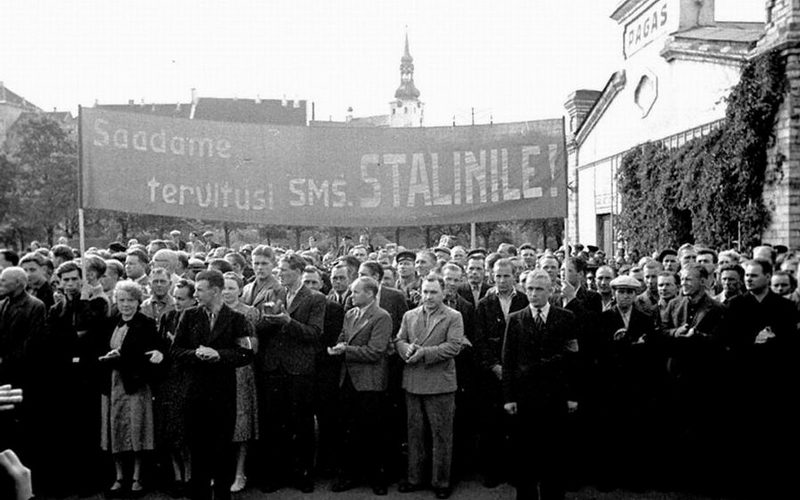The Institute of Russian History of the Russian Academy of Sciences is now preparing the academic review of the most important complex of documents on the history of the Soviet-Baltic relations of the inter-war period. The documents, stored in the Archive of the President of the Russian Federation (APRF), are the so-called “thematic cases” of the Political Bureau of the Central Committee of the All-Union Communist Party of Bolsheviks. Alexander Dyukov, fellow researcher at the Institute of Russian History of the Russian Academy of Sciences and head of the Historical Memory Foundation, is confident that the documents from the “thematic cases” of the Politburo help answer one of the most important questions in the Baltic history: when did the Kremlin make a decision to incorporate the Baltic states into the Soviet Union.
Alexander Dyukov prepared a publication specially for RuBaltic.Ru that shows which documents allow to give an answer to this question. This publication is a part of the project of the Institute of Russian History of the Russian Academy of Sciences that includes the multivolume “Russian History through the Ages”.
The history of the Baltic states losing their independence seem to be well researched at first sight and is not very complex. Every person who was at least a little bit interested in this question, knows a chronological order of the events. September 23, 1939 the Soviet Union and Nazi Germany signed a secret protocol to the non-aggression pact that divided the spheres of influence between two countries. Latvia and Estonia were in the Soviet sphere of influence, Lithuania was in the German one. At the end of September 1939 the agreement was amended, and Lithuania was also included in the Soviet sphere of influence, with certain reservations. Then, at the end of September – early of October 1939, the Soviet Union signed theMutual Assistance Treaty, according to which Latvia, Lithuania and Estonia got Soviet military bases. In June 1940, the Kremlin delivered an ultimatum first to Lithuania, then to Latvia and Estonia: the Baltic states were to create governments loyal to the USSR, and also agree to the new contingent of the Soviet troops to be sent to their countries. The Soviet demands (accompanied by clear threats) were satisfied, and the Baltic states got new units of the Red Army. On July 14, 1940 elections to the People’s Parliaments were held that, at their first meetings, made a decision to create the Latvian, Lithuanian and Estonian SSR and to incorporate them to the Soviet Union. Finally, these decisions were confirmed by the Supreme Court of the USSR in August 3 – 6 1940.
However, the chronological order does not give us an answer, when Moscow decided to incorporate the Baltic states. Did the Soviet government have such plans in August 23 1939, when this infamous secret protocol was signed? Or maybe it got this idea later?
The idea that the Kremlin decided to destroy the independence of the Baltic States in August 23, 1939 or at least in October 1939 was very popular among the Western historians during the Cold War. However, it turned out that this idea was based on non-existing documents, such as the NKVD Order No. 001123 about the organization of deportation of the “hostile element” from the Baltic States, supposedly signed on October 11, 19391.
However, authentic documents that were published show that the Soviet government did not have the intentions to interfere in the internal affairs of the Baltic States after it had signed the Mutual Assistance Treaties in autumn 19392. Sometimes, if local communists asked Soviet military to help them, they were even delivered into the hands of the local political police3.
That is why it is not surprising that nowadays historians almost unanimously say that the Soviet leadership made a decision to take control of the Baltic States in May 1940, and this was connected with the German success in war in the West.
N.S. Lebedeva writes that “German victories that dramatically changed the situation in Europe bothered a lot the Soviet leadership. Stalin expected that there would be a long confrontation between two blocs, but his expectations were not fulfilled. The Reich was about to win its final victory over France and neutralize Great Britain. Then Berlin could forget all Soviet-German agreements. The Kremlin thought that it was a favorable moment, and maybe the last chance, to incorporate the territories that were included in the Soviet sphere of influence according to the secret protocols signed in August – September 1939”4.
Academician A.O. Chubaryan pays attention to the military-strategic aspects of the problem, “After Germany occupied almost the biggest part of Europe and the tension between Germany and the USSR, though hidden, but evident for Moscow, increased, the Soviet leaders had to solve the problem connected with the safety of the country and create more favorable conditions in case of a clash, or even war, with Germany. So Stalin obviously wanted to go forward to the West and to prevent the German penetration into, prevalence over, or even occupation of the Baltic states”5.
E.Y. Zubkova has a similar opinion. “After Germany occupied Norway and Denmark and went to France, Stalin decided that it was time to act. As the balance of power altered in favor of Germany, the Mutual Assistance Treaties seemed to be too unreliable to guarantee the military-strategic interests of the USSR in the Baltic States at the border with East Prussia6.
N.S. Lebedeva was the only historian to try to clarify the date when the Soviet leadership decided to incorporate the Baltic States. She was the first one who paid attention to a remarkable document. In May 23, 1940, the Political Bureau of the Central Committee of the All-Union Communist Party of Bolsheviks made a decision about the repatriation of the Lithuanian population who lived in Belarus at the border with Lithuania to Lithuania (Doc. No 2). As N.S. Lebedeva fairly notices, “it would be a senseless decision, if at this time they would have already started to implement the plan of incorporation of Lithuania into the USSR”7. That is why it was canceled later. In May 23 the repatriation of the Lithuanians to independent Lithuania was not senseless, therefore the Kremlin did not plan to change its politics towards Lithuania by that moment. Considering the fact that by May 25 1940 V.M. Molotov, head of People’s Commissariat of Foreign Affairs, made a very harsh statement to the Lithuanian ambassador, N.S. Lebedeva makes a conclusion, “It seems that Stalin’s leadership made a decision to start its pressure on Lithuania and two other Baltic states in May 24-25, as it wanted to bring into them new big contingents of the Soviet troops and join them to the USSR”8
It is difficult not to agree with the fact that, when in May 23 1940 the Soviet leadership confirmed Politburo’s decision to repatriate the Lithuanians, it did not think about the incorporation of the Baltic States. We publish V.M. Molotov’s memorandum where he justified the necessity to take a decision about repatriation (Doc. No. 1) and a directive of the Council of People’s Commissars of the USSR on the same question (Doc. No.3). Those documents, we believe, are a direct evidence that N.S. Lebedeva made the right conclusion.
We think that the idea that in May 24 – 25 the Kremlin decided upon not only bringing in more Soviet troops to the Baltic states, but about the annexation of the Baltic states in general, seems to us to be too premature, as we have already said9. We think like this also because Politburo’s decision about the repatriation of the Lithuanians was not canceled and was not even put on hold. Instead, as our research done in the National Archives of Belarus shows, the leadership of the republic accepted this decision and started actively to implement it10
We do not find either any traces of intention to occupy the Baltic states in the draft of the official message that Latvia and Estonia accepted the Soviet ultimatums, its text corrected by Stalin (Doc. No. 4 – 5). This fact does not prove anything, unlike the memorandum dated June 22 1940, written by N.G. Kusnetsov, People’s Commissar of the Navy, (Doc. No. 6). In this document, Kusnetsov attracts Stalin’s attention to the necessity to sign the lease agreement for the new territories near Tallinn and Liepaja. This offer got the approval from the Soviet leadership. A few weeks later, in July 6 1940, the lease agreement, providing for the Soviet military use of the new territories, was concluded with the Estonian government11.
The Kremlin’s decision to conclude the lease agreements for military use of the new territories with the Baltic states shows that, at least at the end of June 1940, it did not make a decision yet to incorporate the Baltic States in the Soviet Union. Otherwise there was no sense to conclude such agreements. The Kremlin still followed the old concept of placing military bases in formally independent states.
When was the decision about the annexation made? We do not find a direct answer to this question in the declassified “thematic cases”, but we know it from other sources. On the night of July 2, 1940, V.M. Molotov, People’s Commissar of Foreign Affairs, was meeting Vincas Krėvė-Mickevičius, a minister of foreign affairs and a member of “people’s government” of Lithuania, in Moscow. During their conversation Molotov clearly showed the intention of the Soviet leadership to incorporate the Baltic States into the USSR[12].12
Therefore, we can say that a decision to incorporate the Baltic States was made in the Kremlin no earlier than on June 22 and no later than July 1, 1940. We think that the more possible dates are the last days of June, however, it is necessary to clarify this question.
The documents in “thematic cases” describing the efforts to solve the question about the Baltic gold stored in foreign banks (Doc. No. 7 -10), clearly show that by July 12 – 13 1940 the Soviet leadership was busy not with incorporation itself, but with the issues connected with future negative consequences of this incorporation. The process of incorporation of the Baltic states was in full swing, and the cancellation of the infamous decision to repatriate the Lithuanians at the end of July was already a formality.
However, the Kremlin demonstrated special treatment of the Baltic states even after their official incorporation. The Baltic embassies in Moscow were dissolved, but plenipotentiary representations were created instead of them (Doc. No. 13). When dealing with Lithuanian economic issues, Moscow based itself upon the trade agreement of October 15, 1939 (Doc. No. 14).
* * *
Most researchers have already rejected, as incorrect, the version that the decision to incorporate the Baltic states into the USSR was made between August and October of 1939. As seen from the new documents from the Archive of the President of the Russian Federation, now introduced into scientific discourse, the idea that the decision to incorporate them was taken at the end of May 1940 was also false. Late in May, the Soviet leadership only decided to bring in new contingents of the Soviet troops to the Baltic republics. The decision to incorporate the Baltic states in the USSR was taken by the Soviet leadership as late as the end of June 1940.
Documents
Doc. No. 1. Memorandum by People’s Commissar for Foreign Affairs V.M. Molotov sent to: the Politiburo of the Party’s Central Committee, regarding: the arrangement of repatriation of Lithuanian population from Belorussian border areas to Lithuania. [May 23, 1940, or earlier]. APRF, 3-65-990, pp.143-144.
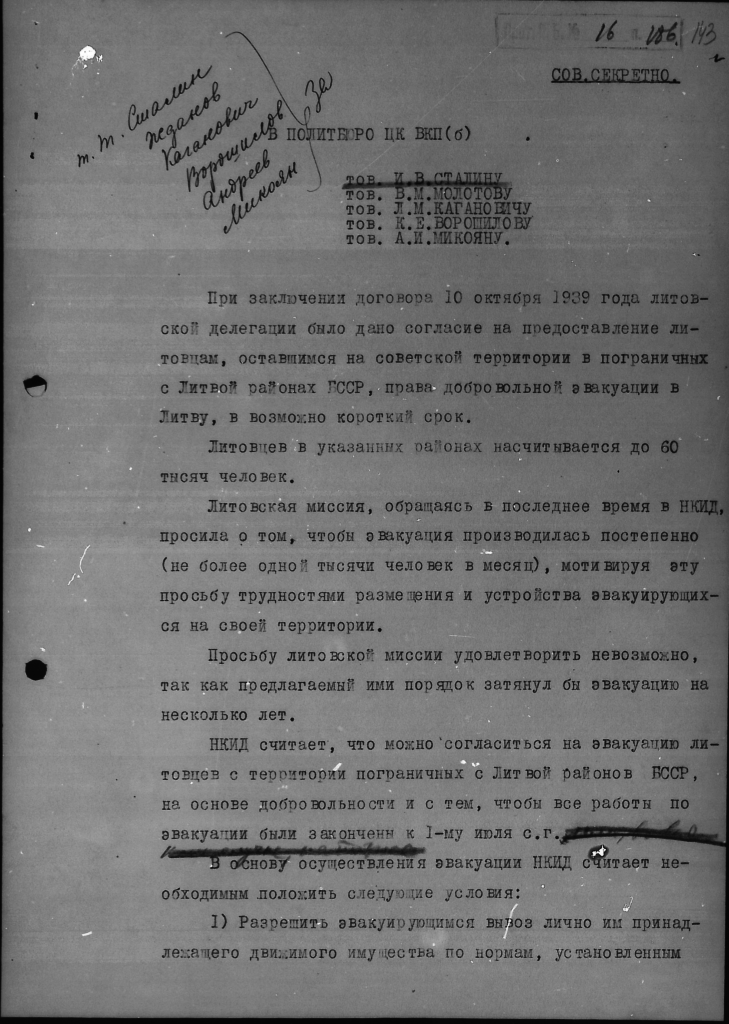

Doc. No. 2. Abstract from the minutes of the Politburo of the Party’s Central Committee regarding: the arrangement of repatriation of Lithuanian population from Belorussian border areas to Lithuania. May 23, 1940. APRF, 3-65-990, pp. 141-142.

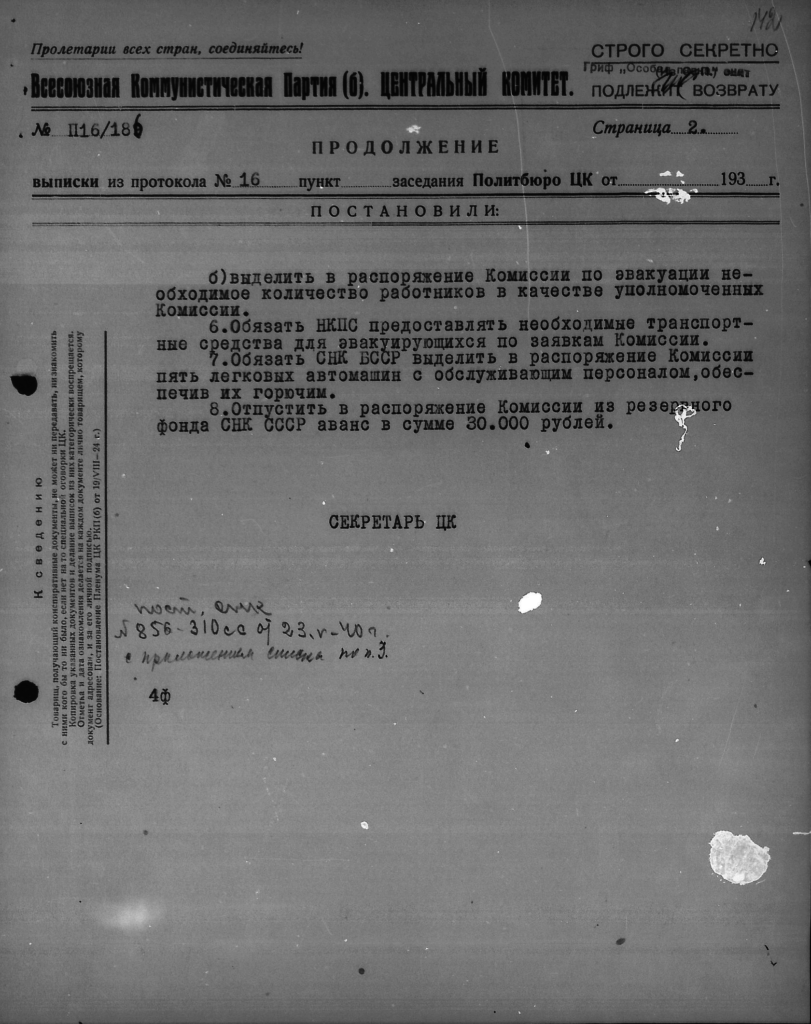
Doc. No. 3. Directive of the Council of People’s Commissars on the arrangement of repatriation of Lithuanian population from Belorussian border areas to Lithuania. May 23, 1940. APRF, 3-65-990, pp. 145-146.

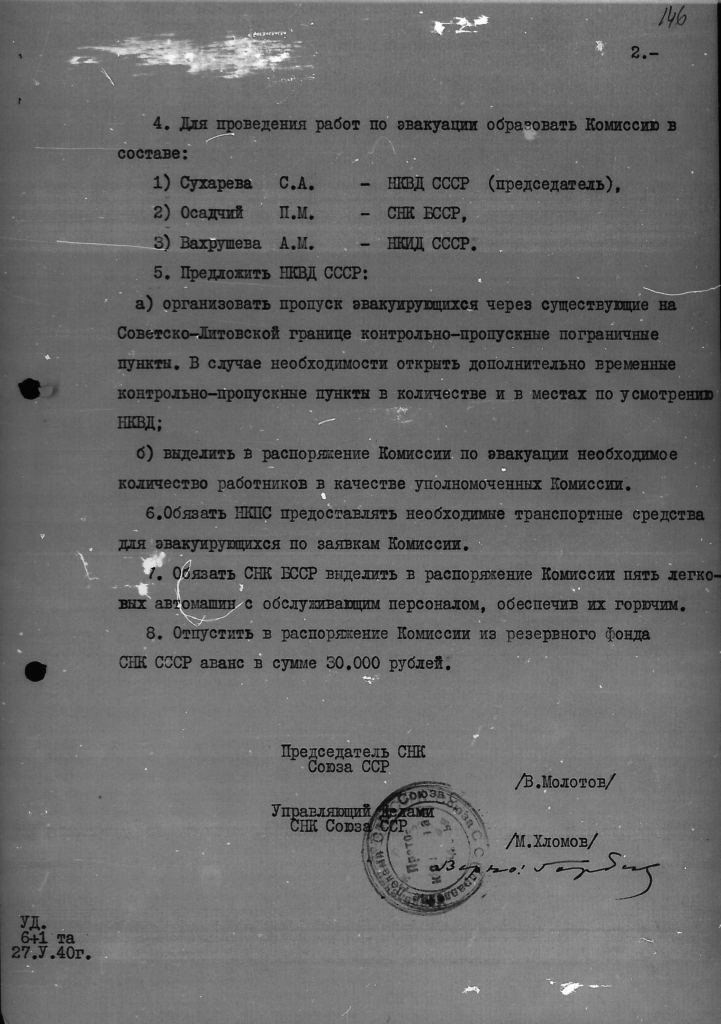
Doc. No. 4. A draft version of a TASS report on Soviet-Latvian and Soviet-Estonian relations with Stalin’s handwritten remarks. June 16, 1940. APRF, 3-65-970, pp. 162-164.
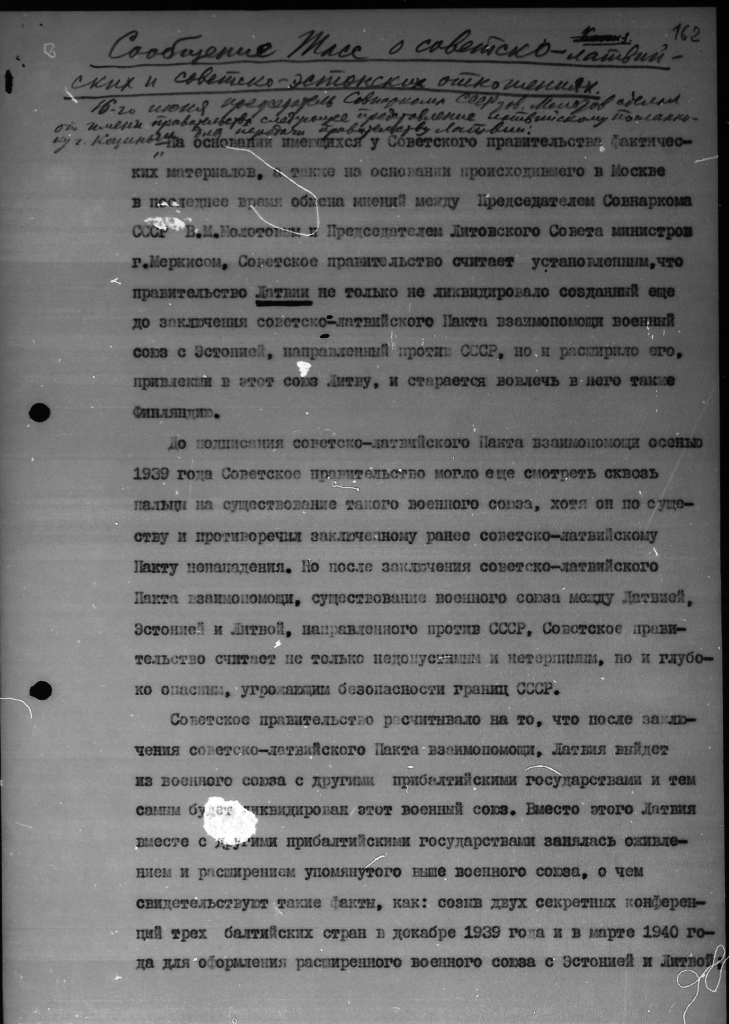
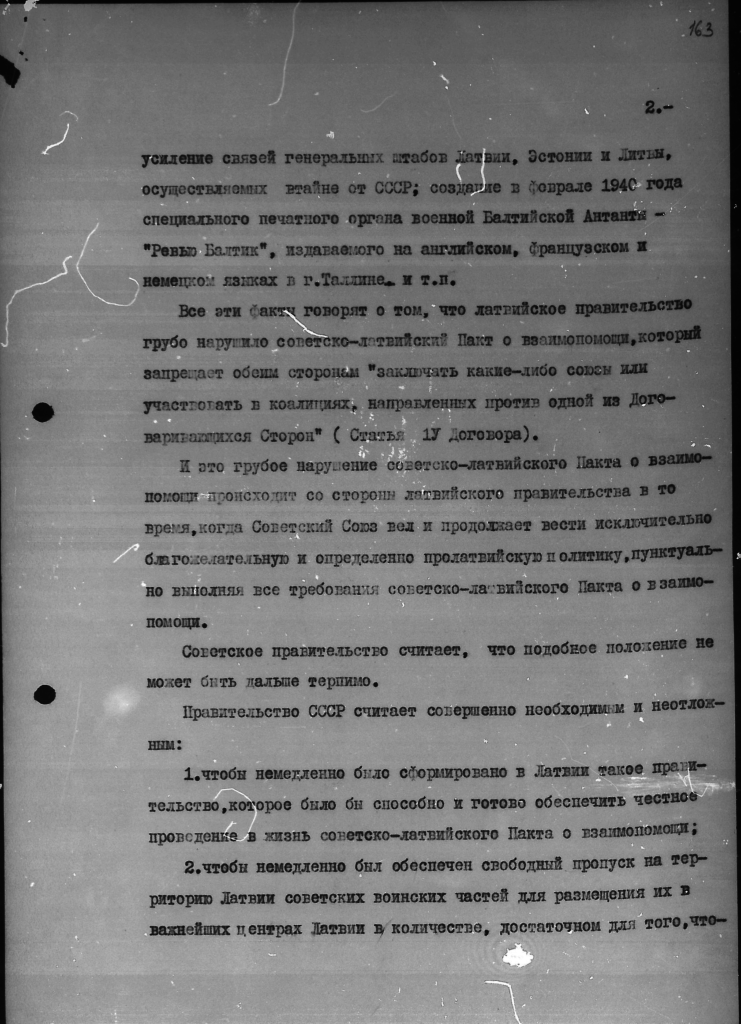
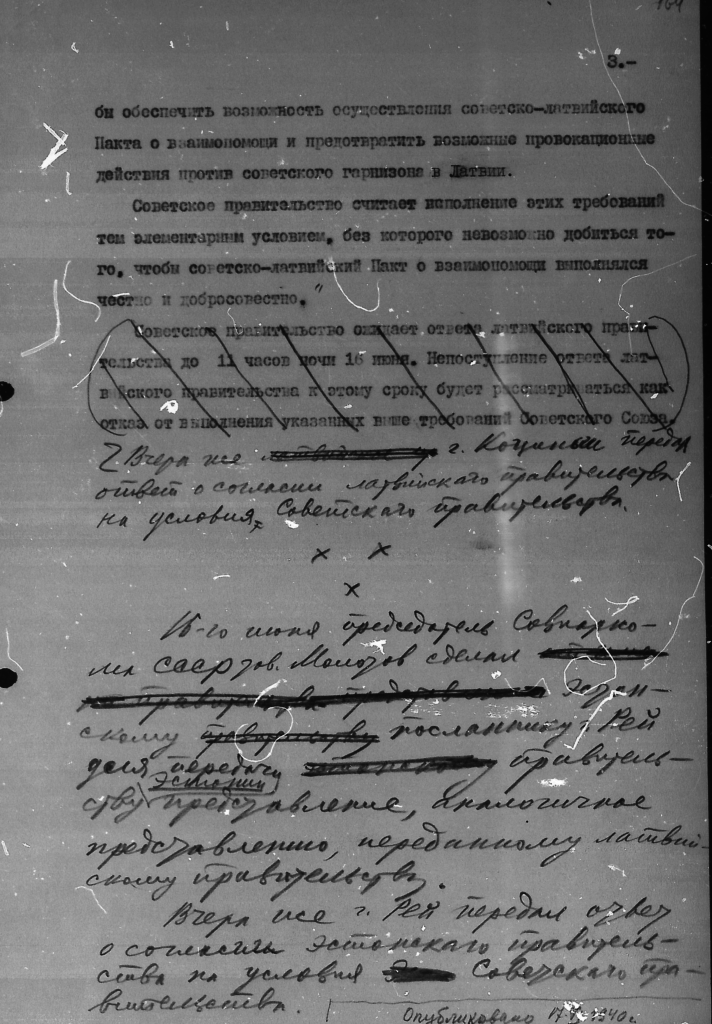
Doc. No. 5. TASS reports on Soviet-Latvian and Soviet Estonian relations. June 17, 1940. APRF, 3-65-970, p. 165.

Doc. No. 6. Memorandum by People’s Commissar for the Navy N.G. Kuznetsov sent to: the Central Party Committeem regarding: the need to conclude, with the Latvian and Estonian governments, agreements for the lease of territories near Tallinn and Libava (Liepāja). June 22, 1940. APRF, 3-66-885, pp. 102-104.
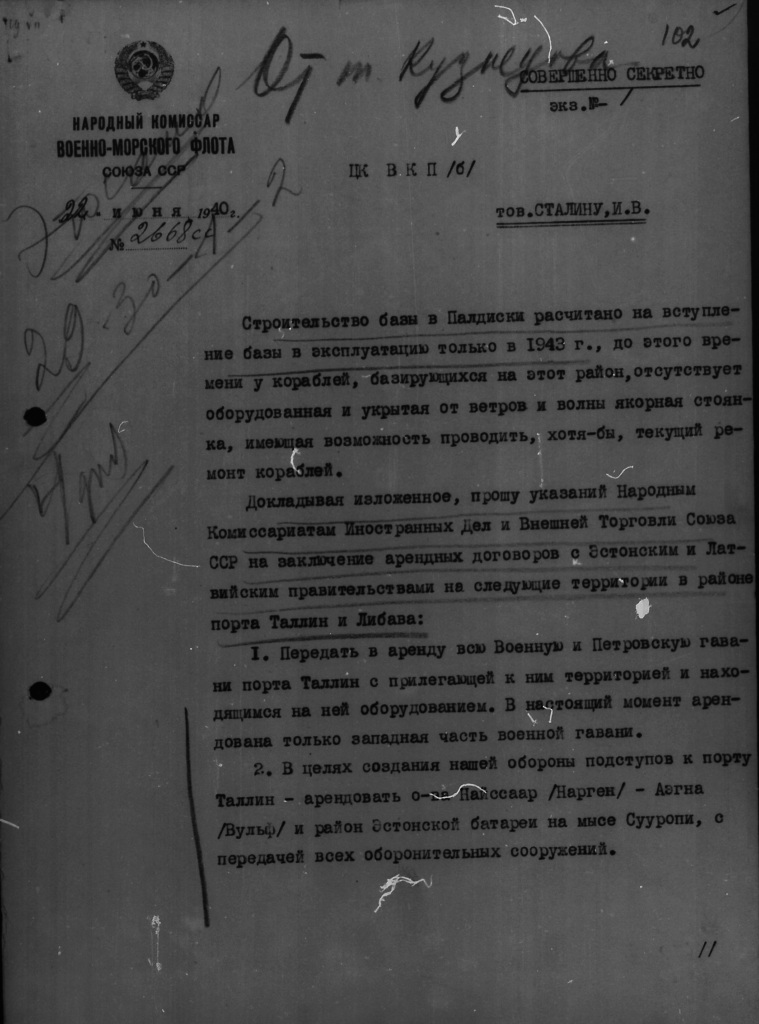

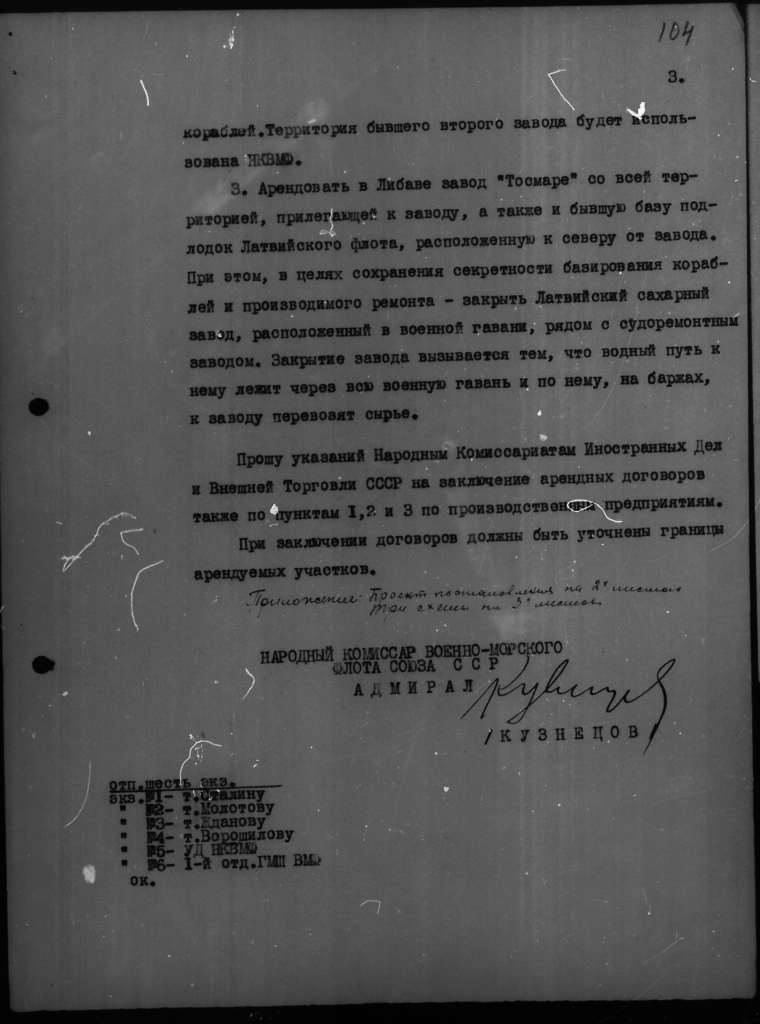
Doc. No. 7. Ciphered telegram from People’s Commissar for Foreign Affairs V. M. Molotov and People’s Commissar for External Trade A.I. Mikoyan to Soviet representatives in Lithuania, regarding: the need to conclude an agreement with the Bank of Lithuania on the purchase of gold kept on storage in the United States. July 12, 1940. APRF, 3-65-990, p. 177.
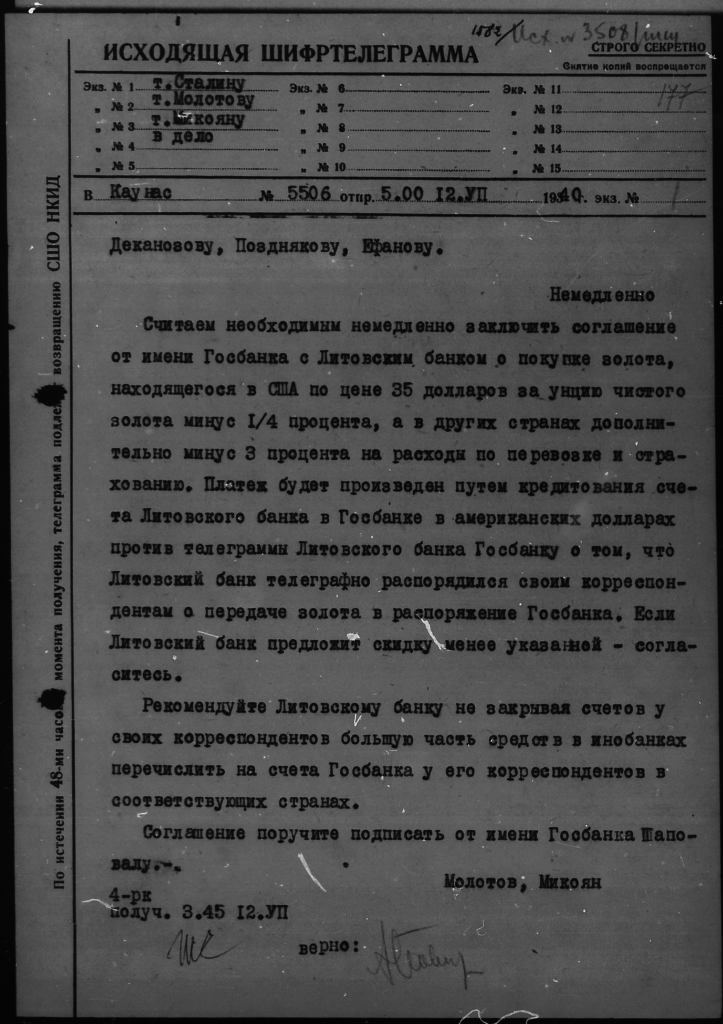
Doc. No. 8. Ciphered telegram from People’s Commissar for Foreign Affairs V. M. Molotov and People’s Commissar for External Trade A.I. Mikoyan to Soviet representatives in Latvia, regarding: the need to conclude an agreement with the Bank of Latvia on the purchase of gold kept on storage in the United States. July 12, 1940. APRF, 3-65-970, p. 166.

Doc. No. 9. Telephoned telegram of V. G. Dekanozov, Authorized Representative of the Council of People’s Commissars in Lithuania, regarding the Lithuanian decision to sell gold kept in foreign banks. July 13, 1940. APRF, 3-65-990, p. 178.
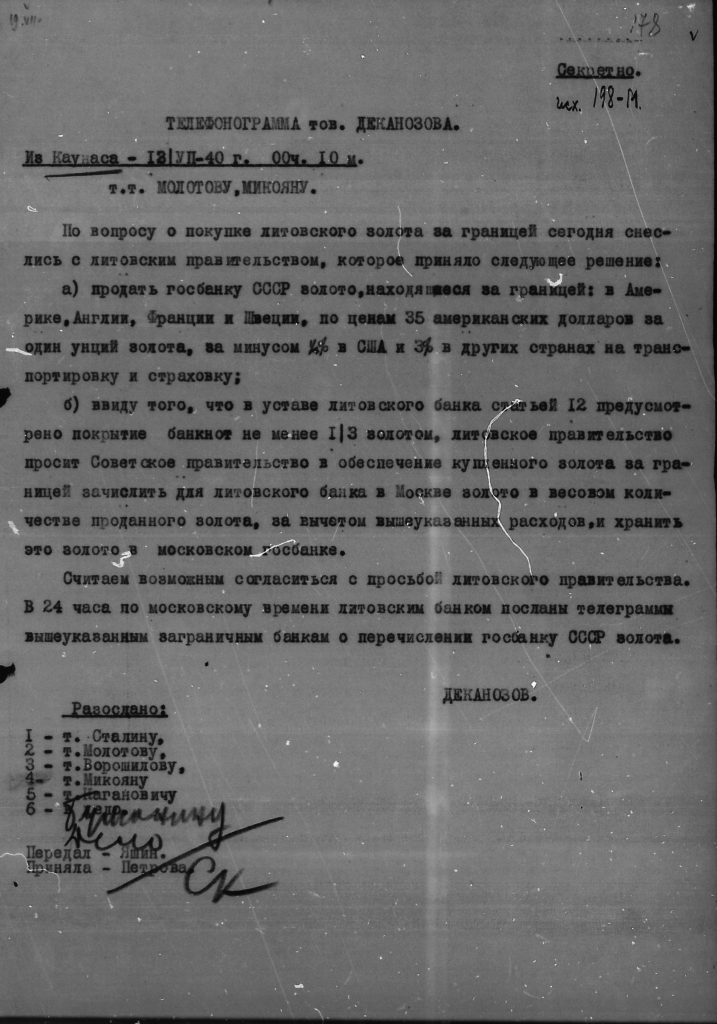
Doc. No. 10. Telephoned telegram from V.K. Derevyansky, Soviet envoy to Riga, regarding the Lithuanian decision to sell gold kept in foreign banks. July 13, 1940. APRF, 3-65-970, pp. 167-168.
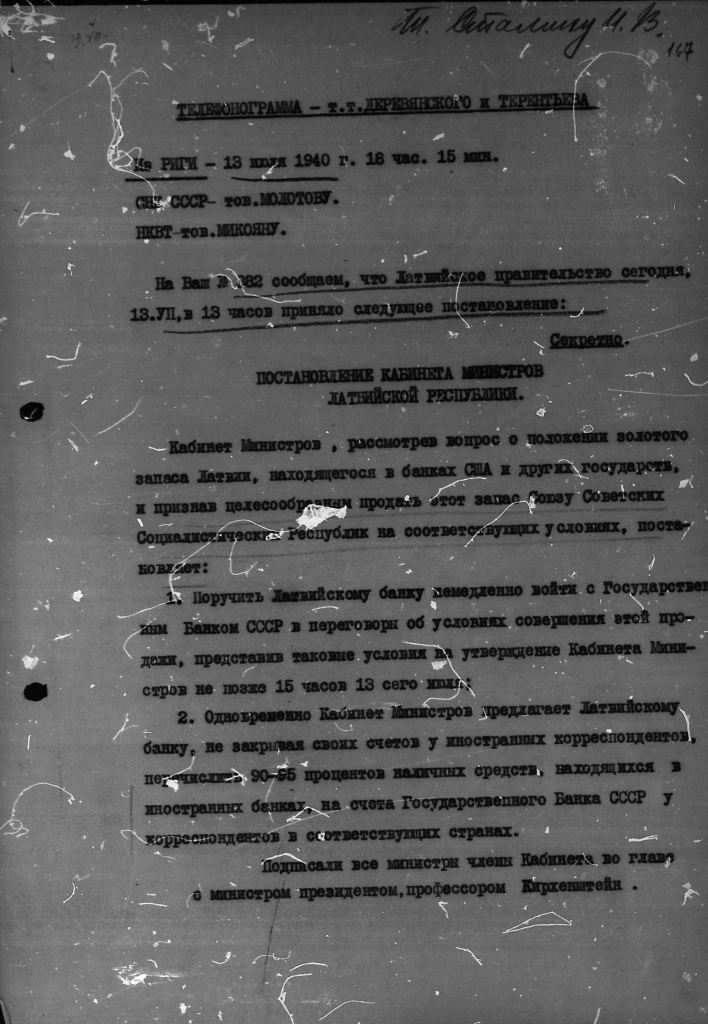
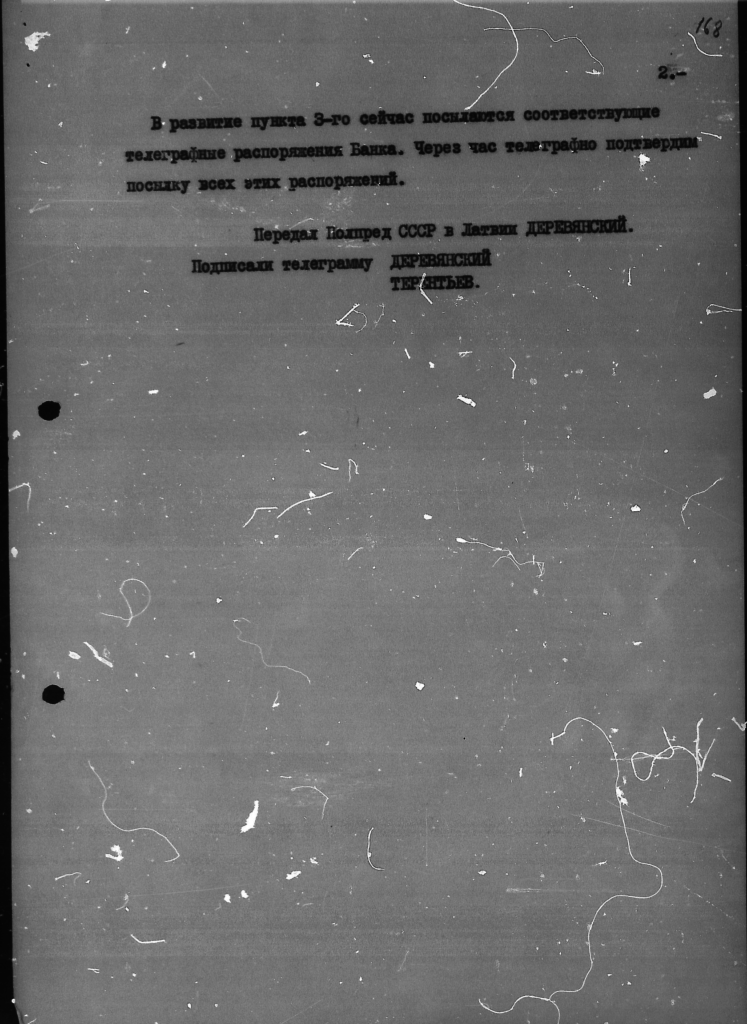
Doc. No. 11. Memorandum by People’s Commissar for the Interior L.P. Beria on the rationale for the withdrawal of the directive on the repatriation of Lithuanians from the Belorussian SSR border areas to Lithuania. July 26, 1940. APRF, 3-65-990. p. 181.
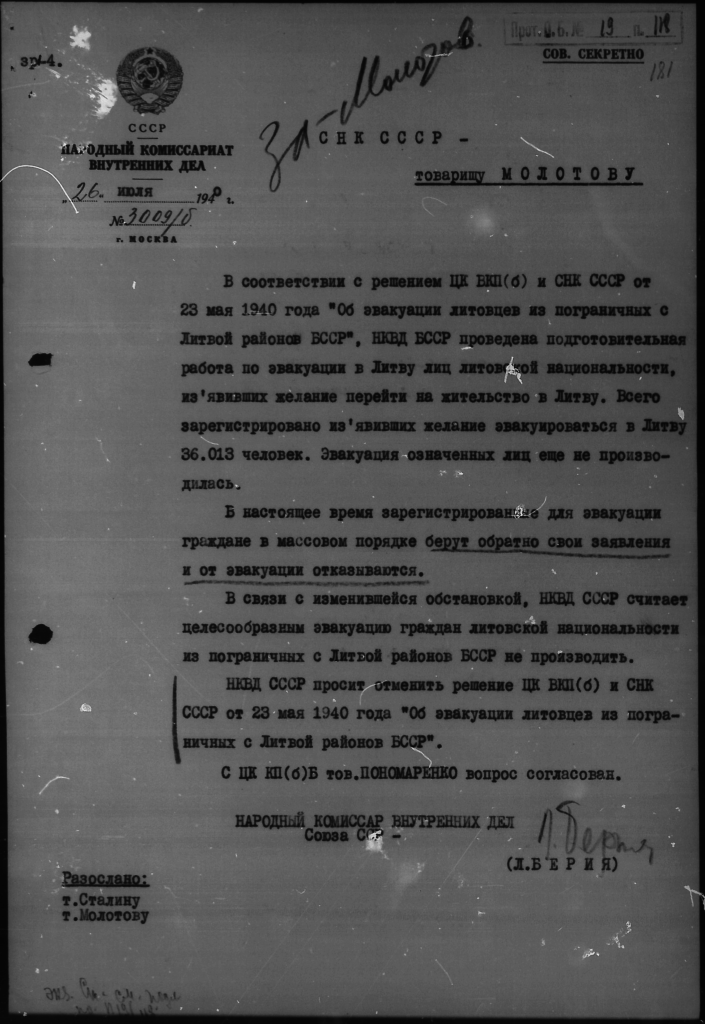
Doc. No. 12. Abstract of the minutes of the Politburo meeting cancelling the directive on the repatriation of Lithuanians from the Belorussian SSR border areas to Lithuania. July 29, 1940. APRF, 3-65-990, p. 180.
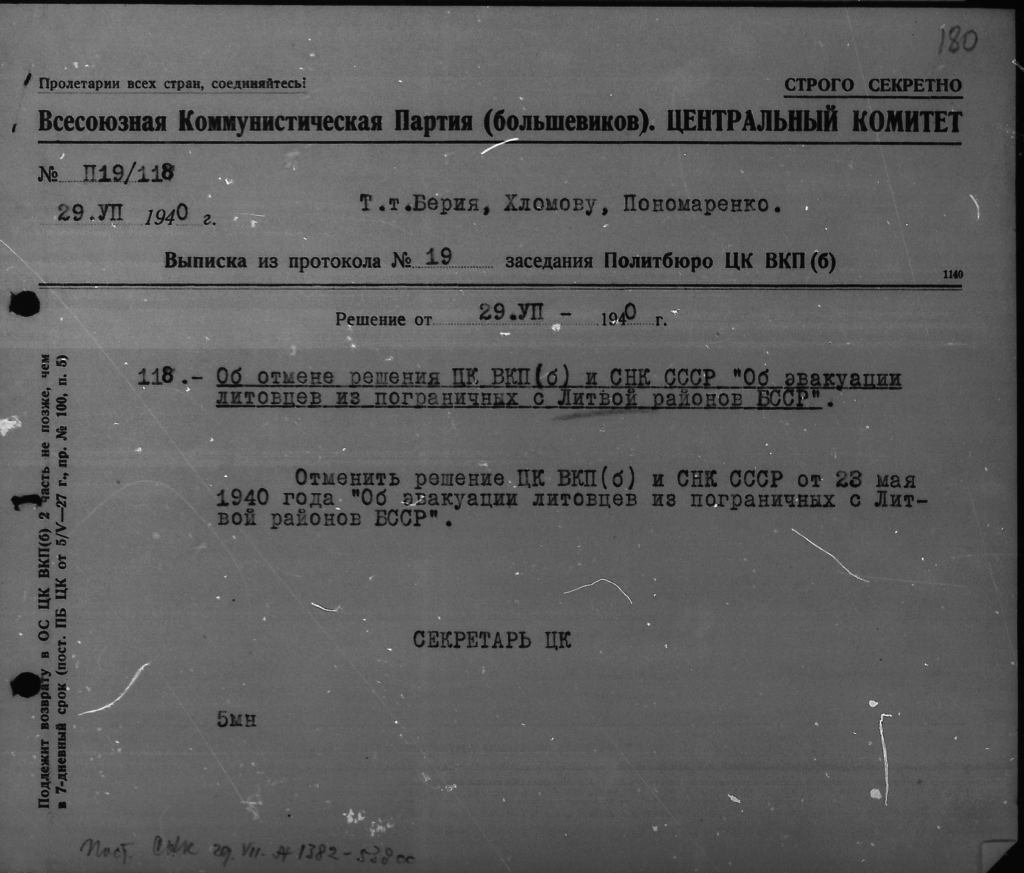
Doc. No. 13. Abstract of the minutes of the Politburo meeting dissolving the Latvian, Lithuanian and Estonian embassies in Moscow and creating plenipotentiary representations instead. August 14, 1940. APRF, 3-65-990, p. 182.
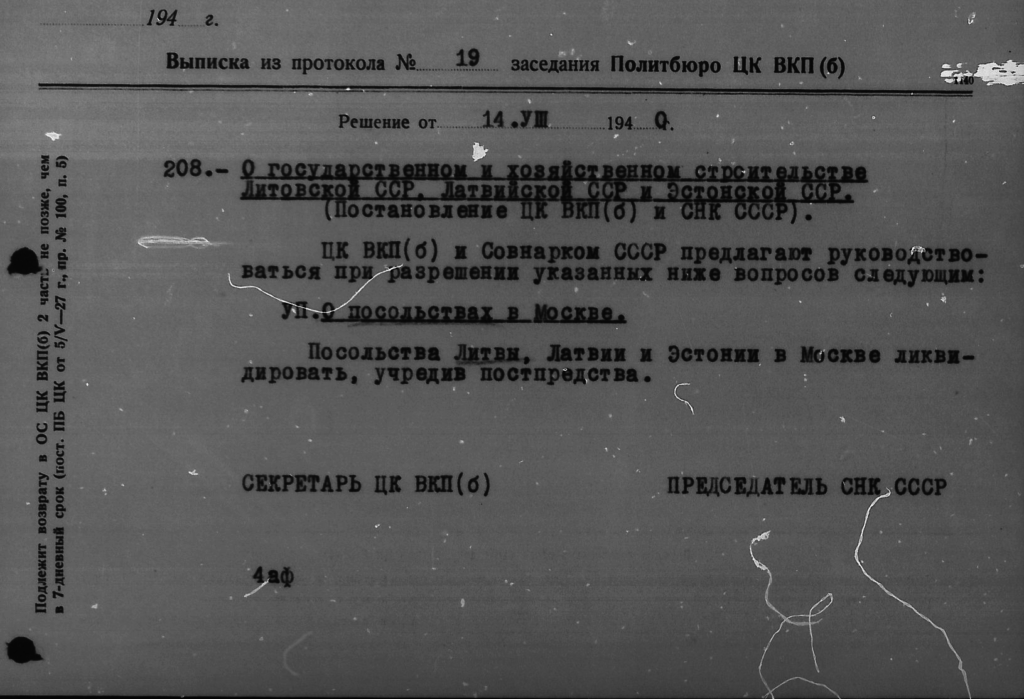
Doc. No. 14. Abstract from the minutes of the Politburo meeting on providing the government of the Lithuanian SSR with extra materials and goods, in excess of the norm stipulated by the Soviet-Lithuanian Trade Agreement of October 15, 1939. September 6, 1940. APRF, 3-65-990. p. 183–186.

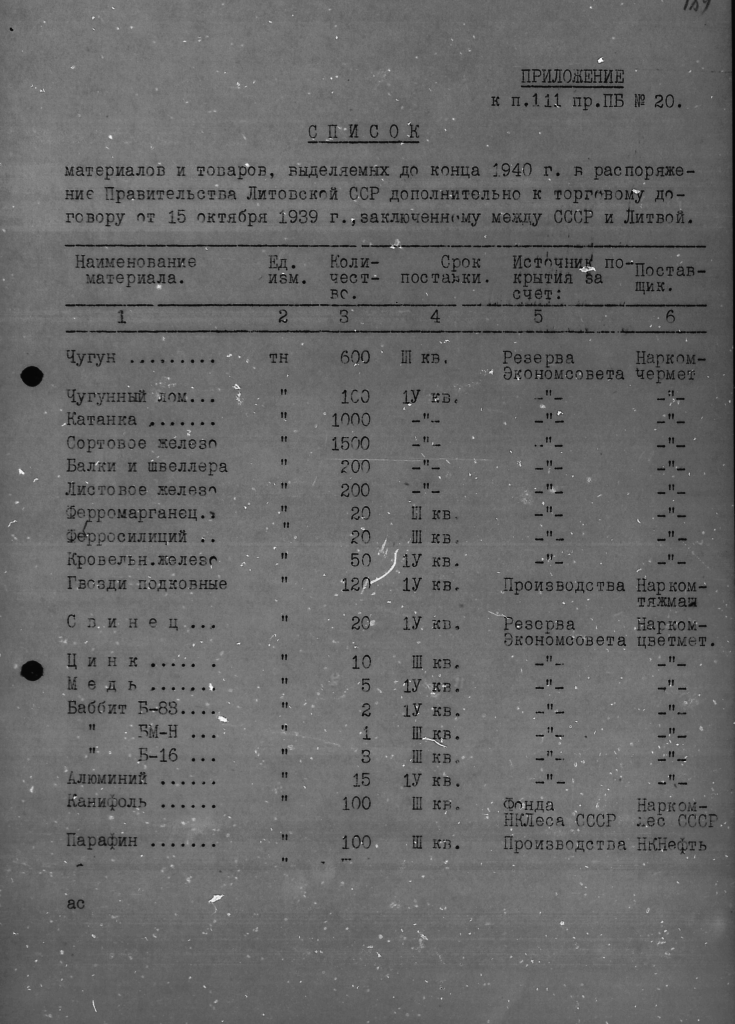
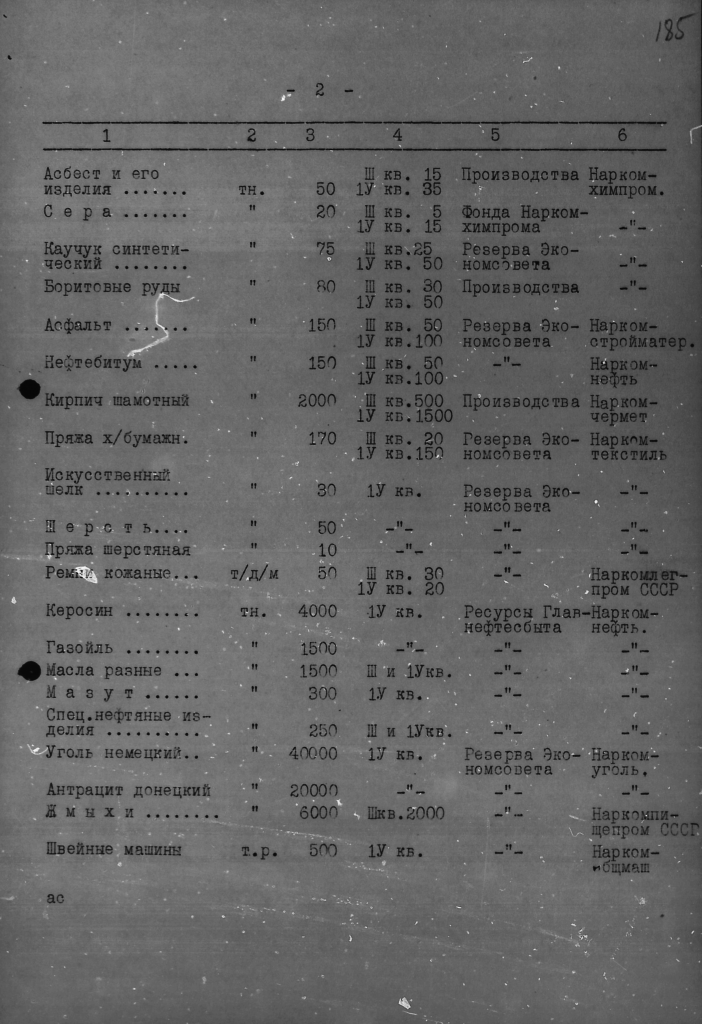

ReFERENCES:
- For more detail about this historiographic error, See: Dyukov A.R. Likvidatsiya «vrazhdebnogo elementa». Natsionalisticheskiy terror i sovetskiye repressii v Vostochnoy Evrope. M., 2017. S. 281-283, 370-372. (On Russian.)
- Polpredy soobshchayut… Sbornik dokumentov ob otnosheniyakh SSSR s Latviyey, Litvoy i Estoniyey. Avgust 1939 – avgust 1940 g. M.. 1990. S. 123, 140, 144., 151-152, 159. (On Russian).
- Vynuzhdennyy alians. Sovetsko-baltiyskiye otnosheniya i mezhdunarodnyy krizis 1939 – 1940: Sbornik dokumentov. M.. 2019. S. 27. (On Russian.)
- Lebedeva N. Germaniya i prisoyedineniye Litvy k SSSR // Mezhdunarodnyy krizis 1939 – 1941 gg.: Ot sovetsko-germanskikh dogovorov 1939 g. do napadeniya Germanii na SSSR. M.. 2006. S. 254. (On Russian.)
- Chubarian A.O. Kanun tragedii. Stalin i mezhdunarodnyy krizis. sentyabr 1939 – iyun 1941 goda. M.. 2008. S. 260-261. (On Russian.)
- Zubkova E.Y. Pribaltika i Kreml. M.. 2008. S. 77. (On Russian.)
- Lebedeva N. Germaniya i prisoyedineniye Litvy k SSSR… S. 254.
- SSSR i Litva v gody Vtoroy mirovoy voyny. T. 1: SSSR i Litovskaya Respublika (mart 1939 – avgust 1940 gg.): Sbornik dokumentov. Vilnius. 2006. S. 49. (On Russian.)
- Dyukov A.R. Protektorat «Litva». Taynoye sotrudnichestvo s natsistami i nerealizovannyy stsenariy utraty litovskoy nezavisimosti. M.. 2013. S. 13. (On Russian.)
- National Archives of Belarus, 4p-1-16720. p. 44.
- Polpredy soobshchayut… S. 455-457.
- Krėvė V. Bolševikų invazija ir liaudies vyriausybė: atsiminimai. Vilnius, 1992. P. 14-15. (On Lithuanian.); SSSR i Litva… Т. 1. S. 720-721.
